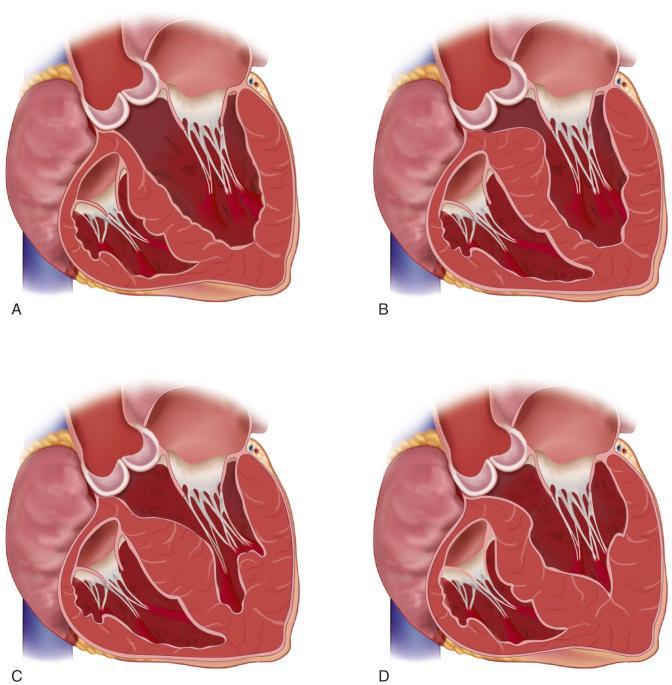Physical Address
304 North Cardinal St.
Dorchester Center, MA 02124
Knowledge of the anatomy involved with hypertrophic cardiomyopathy (HCM) is paramount in understanding the pathophysiology that ultimately contributes to dynamic subaortic obstruction.
HCM is defined as left ventricular (LV) hypertrophy in the absence of another underlying cause, such as aortic valve stenosis, systemic hypertension, or metabolic disorders, such as Fabry disease or amyloidosis.
Septal hypertrophy and systolic anterior motion (SAM) of the anterior mitral leaflet combine to produce LV outflow obstruction, as well as mitral valve regurgitation in varying degrees. Previously, LV outflow tract (LVOT) obstruction was thought to be present in a minority of patients, but it is common in symptomatic patients with HCM.
Patients display varying degrees and distribution of LV hypertrophy, ranging from the anterior basal septum (most common) to the apex ( Fig. 29.1 ). Midventricular obstruction may occur if the hypertrophied septum comes into contact with the papillary muscles.

Dynamic SAM of the mitral leaflets contributes to obstruction by narrowing the LVOT. The mechanism is thought to be due to the Venturi effect in the LVOT. In addition, one study has documented increased lengths of the mitral leaflets in HCM; a ratio of anterior mitral leaflet length to LVOT diameter more than 2.0 was found to be associated with obstruction. An added consequence of SAM is varying degrees of mitral regurgitation, which contributes to the patient's symptoms of dyspnea and fatigability.
Abnormalities of mitral valve chordae and papillary muscles are present in 15% to 20% of patients, but these do not always contribute to outflow tract obstruction or mitral valve dysfunction (e.g., false chords). Direct insertion of the papillary muscle to the body of the anterior mitral valve leaflet may contribute to outflow tract obstruction.
In obstructive HCM, the aortic valve is usually normal, in contrast to congenital subaortic stenosis, in which turbulence due to a subaortic membrane and muscular obstruction often leads to cusp retraction and aortic valve regurgitation.
As seen by echocardiography or cardiac magnetic resonance imaging (MRI), the most common pattern of hypertrophy is diffuse involvement of the ventricular septum. LV wall thickness typically ranges from 20 to 22 mm; however, 5% to 10% of patients have a wall thickness ranging from 30 to 50 mm, and some patients have SAM with a septal thickness of less than 29 mm.
LVOT obstruction is characterized on Doppler echocardiography by a high-velocity, late-peaking signal, sometimes described as dagger-shaped. Patients with no resting obstruction may reveal latent obstruction with provocative maneuvers, as described in the following.
The surgeon should identify the level of LVOT obstruction relative to SAM because this will ultimately guide the surgical approach. At times, the white endocardial fibrous scar on the septum demarcating the area of contact between the septum and the anterior mitral leaflet can be identified on an echocardiogram.
Transthoracic echocardiography is also used to identify any primary mitral valve pathologies that need to be addressed intraoperatively, including abnormal papillary muscles and their insertion.
Become a Clinical Tree membership for Full access and enjoy Unlimited articles
If you are a member. Log in here